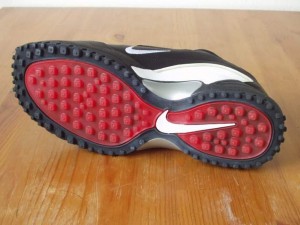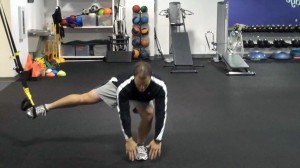It has been known for years that increased coefficient of traction can predispose the knee to catastrophic injury. Hence, the reason we got rid of all the old style astro turf in football stadiums. But, traction is influenced by the sole architecture of the shoes as well as the playing surface. Unfortunately, we are not fully aware of how exactly the sole architecture or this increased traction can lead to injury.

Nike Astro Turf Shoe
Does footwear really matter? I say YES. Case in point – I am not a big fan of Nike Shox because they position the ankle in a plantar flexed position, thereby making it so much easier for ankles to roll inward with cutting. I have seen too many female athletes suffer inversion sprains while running suicides or training in these shoes. I simply believe the design creates a biomechanical mismatch and elevated risk for ankle sprains.
Now what about traction? A study in the American Journal of Sports Medicine by J Wannop et al. recently looked at the difference between two shoe designs in a controlled laboratory study. The tread types of shoes used were either smooth or tread.
The shoe used in the study was the adidas Response 2+ CPT (smooth shoe) and adidas Response=2(A) (tread shoe). The traction testing was performed using a robotic testing machine, while the researchers also observed 13 recreational athletes performing 45 degree V cuts in both shoes. Data was collected using 8 high speed cameras and a force plate.
The results are not shocking. The highlights are:
- The coefficient of translational traction and peak moment of rotation were both significantly higher in the tread show compared to the smooth shoe.
- In addition, the high-traction shoe had much higher peak ankle externalrotation moments, peak knee external rotation moments, peak knee adduction moments, and knee adduction angular impulse compared to low-traction shoe.
The findings of the study indicate that the resultant joint loading increased 12% in the ankle (transverse plane) and 13% and 20% in the transverse and frontal planes for the knee. This increased traction is certainly enough to push the knee into the previously reported mechanical rupture zone.
What we cannot deduce is whether the increases in joint loading is strictly attributable to the higher linear and rotational traction or if there is even a linear relationship between them at all.
You should also note that athletes often choose traction shoes for enhanced performance. In this study, there was no significant difference in the performance measured between the two groups. So, we are left to ponder whether we really need higher traction shoes at all. Future studies will need to address this relationship as preventing knee and ankle injuries just by adjusting footwear seems like a no-brainer if the science supports this.




